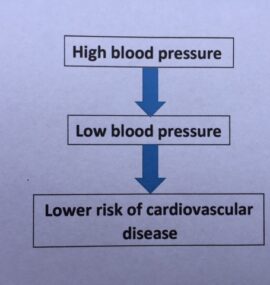High blood pressure predicts bad health outcomes
Keep Moving and Eat Better to reduce your blood pressure
High blood pressure (hypertension) accounts for a substantial fraction of US medical care costs. Plus, high blood pressure predicts increased risk of other bad health outcomes including cardiovascular disease, stroke, and vascular dementia. The American College of Cardiology and the American Heart Association Task Force on Clinical Practice Guidelines wrote a lengthy and detailed guideline on preventing, detecting, evaluating, and managing high blood pressure. Until recently, hypertension was defined as systolic (the top number) and diastolic (the bottom number) blood pressure readings of 140 or 90 mm Hg or higher, respectively. By this definition, 32 percent of American adults have hypertension. The prevalence rises with age (64 percent for seniors). Higher proportions of African-Americans have hypertension in all age groups.
The more recent definition lowers the threshold blood pressures to 130 and 80 mm Hg, respectively. By this definition, 46 and 77 percent of Americans adults and seniors, respectively, have hypertension. In 2021, the American Heart Association and the American College of Cardiology pegged “normal” blood pressure at less than 120/80. Risk factors for hypertension include smoking, type 2 diabetes, overweight/obesity, low physical activity, low cardiorespiratory fitness, excess blood fats, and poor diet. Looked at from the positive side, if you adopt the healthy lifestyle choices of Keep Moving and Eat Better you’ll substantially reduce your risk of hypertension.
Cardiovascular disease kills more Americans than any other cause. Hypertension holds the dubious distinction as the most the most common and costly risk factor for cardiovascular disease. The American College of Sports Medicine recently conducted a systematic review of published studies and issued a pronouncement regarding the ability of physical activity to prevent and treat hypertension. Strong evidence shows that physical activity reduces blood pressure among adults with normal blood pressure, pre-hypertension or hypertension – in other words, everyone! Further, strong evidence shows that risk of new hypertension declines in a straight line as physical activity increases in adults with normal blood pressure. Finally, strong evidence shows that the greatest benefit of physical activity in reducing blood pressure arises in adults with hypertension, less so in adults with pre-hypertension, and even less so in adults with normal blood pressure. The clear messages: Increased physical activity can lower your blood pressure and lower risk of developing hypertension – and perhaps reverse hypertension. Find an enjoyable way to increase your level of physical activity and turn it into a healthy habit.
Doctors typically treat high blood pressure with medications, but some patients do not respond favorably to drugs. Such patients have what’s called resistant hypertension. Recent studies suggested that aerobic exercise meaningfully reduce blood pressure in resistant hypertensive patients. Unfortunately, methodological flaws clouded interpretation of the results. A new study, the Exercise Training in the Treatment of Resistant Hypertension, overcame these limitations. Researchers in Portugal recruited 60 resistant hypertensive patients for a 12-week study. Half of the patients participated in the supervised aerobic exercise program. It included thrice-weekly cycling and/or walking sessions for 40 minutes at up to 70 percent of maximum oxygen intake (VO2 max). The other half of the patients received usual care, which consisted of advice on healthy lifestyle choices and the best-tolerated drug treatment.
Over 12 weeks, patients in the exercise program significantly and meaningfully lowered their 24-hour ambulatory systolic and diastolic blood pressure by 6.2 and 4.4 mm Hg, daytime systolic and diastolic blood pressure by 7.3 and 5.0 mm Hg, and office systolic and diastolic blood pressure by 10.9 and 5.9 mm Hg. Systolic and diastolic blood pressure in patients in the usual care increased or decreased by about 1 mm Hg. Previous research showed that decreases in systolic or diastolic blood pressure of 10 and 4 mm Hg, respectively, predicted 30 lower risk of stroke and 20 percent lower risk of heart attack. If you have high blood pressure, talk to your doctor about aerobic exercise.
The combination of improved diet and higher physical activity predicts improvements in systolic and diastolic blood pressure in patients with hypertension. But do these results apply to patients with resistant hypertension? Researchers at Duke University addressed this question in the TRIUMPH clinical trial. One hundred forty resistant hypertensive patients with an average of 63 years participated in the 4-month study. Participants in the experimental group received the Center-Based Lifestyle Intervention including dietary counseling, behavioral weight management, exercise at a cardiac rehab facility, and a single counseling session providing Standardized Education and Physician Advice. Participants in the control group received a one-hour educational session.
After four months, participants in the experimental group lowered their systolic and diastolic blood pressure by 12.5 and 5.9 mm Hg compared to 7.1 and 3.7 mm Hg for participants in the control group. Blood pressure values measured over the course of 24-hour periods were significantly lower for participants in the experimental group compared to the control group. The declines in blood pressure were also clinically significant and comparable to those resulting from drug therapy. Fifty-nine percent of the participants in the experimental group resolved their hypertension (that is, blood pressure less than 130/80) compared to 38 percent of participants in the control group. In addition, participants in the experimental showed significantly greater improvements in three cardiovascular disease biomarkers than the control group. Thus, an intensive program that focused on better diet and more exercise and delivered in a cardiac rehab setting substantially reduced blood pressure for resistant hypertensive patients.
The clear message: Keep Moving and Eat Better to achieve and maintain healthy blood pressure and reduce your risk of hypertension and cardiovascular disease.








